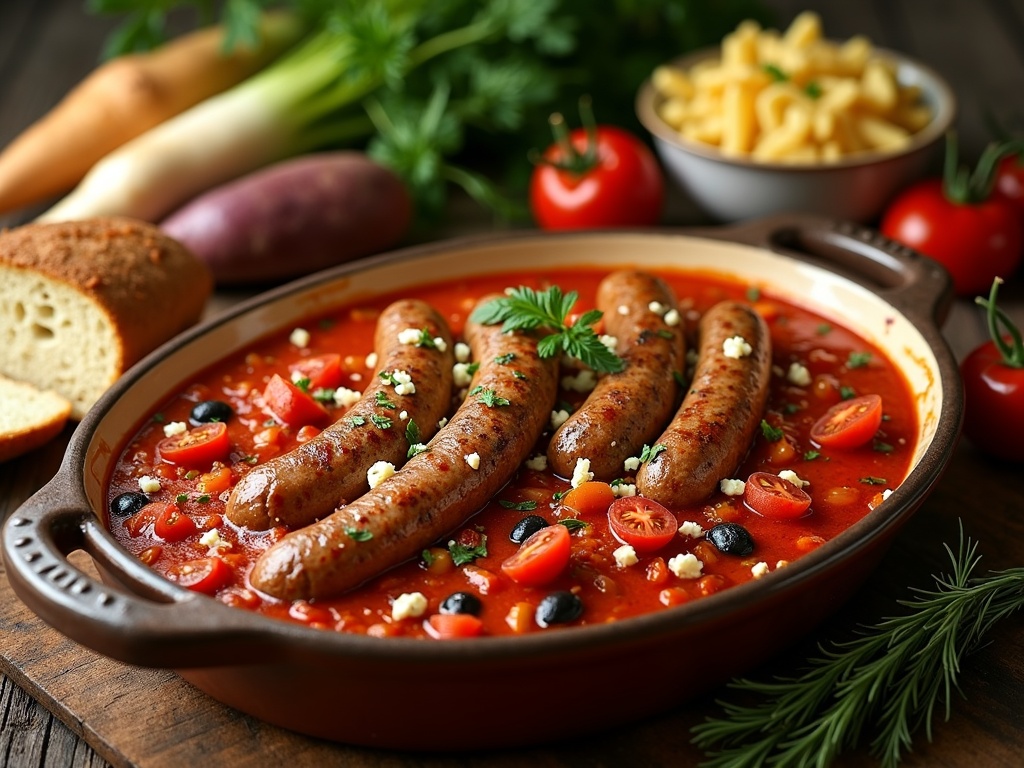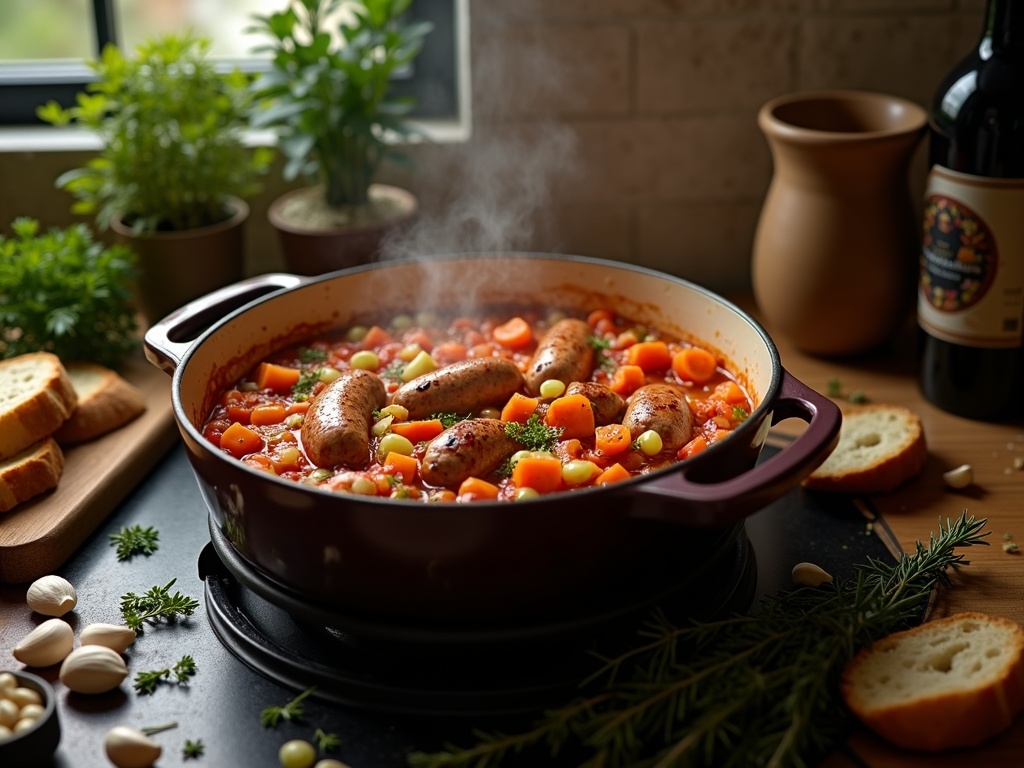Sausage casserole combines rich, savory flavors of quality sausages with slow-cooked vegetables to create a deeply satisfying one-pot meal perfect for any season. This versatile comfort food delivers on taste while offering practical benefits like easy preparation, affordable ingredients, and flavor that improves when made ahead.
Find In This Article
Key Takeaways
- Browning sausages properly creates a caramelized exterior that develops deep flavor throughout the dish.
- The dish is a practical one-pot wonder that’s budget-friendly and easily scales to feed a crowd.
- Vegetables should be added in stages based on cooking time, with root vegetables first and delicate ingredients last.
- Sausage casserole freezes exceptionally well for up to three months, making it perfect for meal prep.
- The dish pairs beautifully with various sides including mashed potatoes, crusty bread, or rice depending on preference.
The Ultimate Comfort Food For Any Season
Nothing says comfort quite like a hearty sausage casserole simmering away on the stove. I’ve found this dish to be a reliable staple in my home cooking repertoire because it ticks all the boxes: satisfying, simple, and suitable for any season.
A Perfect Blend of Flavors
A good sausage casserole brings together the rich, savory notes of quality sausages with the natural sweetness of slowly cooked vegetables. The magic happens when everything cooks together, creating a depth of flavor that’s hard to beat. I like to start with high-quality halal sausages as the foundation – they release just enough fat to flavor the dish without making it greasy.
The vegetables aren’t just supporting players in this dish; they provide essential balance. Onions, carrots, and celery form what’s often called a mirepoix, creating a flavor base that complements the meatiness of the sausages. Add some beans, tomatoes, and perhaps a handful of herbs, and you’ve got something truly special that tastes like it took hours of complex preparation when it really didn’t.
Practical Benefits Beyond Taste
This dish isn’t just delicious – it’s wonderfully practical too. Here’s why I regularly turn to sausage casserole when meal planning:
- It’s a genuine one-pot wonder, minimizing both preparation and cleanup time.
- The recipe easily scales up to feed unexpected guests or provide leftovers.
- It’s surprisingly budget-friendly, especially when feeding a family.
- The dish actually improves in flavor when made ahead, making it perfect for busy weeknight dinners.
- Freezes beautifully for up to three months, creating your own homemade convenience food.
I’ve found few dishes that offer this combination of flavor and convenience. The relatively hands-off cooking process means I can prepare it when I have a spare hour on the weekend, then reheat portions throughout the week. This makes it perfect not just for family dinners but also for batch cooking sessions.
For even more comfort food inspiration, check out my classic cottage pie recipe or try my chicken and mushroom pie when you’re craving something equally satisfying but different.
Whether served with fluffy mashed potatoes in winter or a simple green salad in summer, sausage casserole adapts to any season while maintaining its status as the ultimate comfort food that never disappoints.
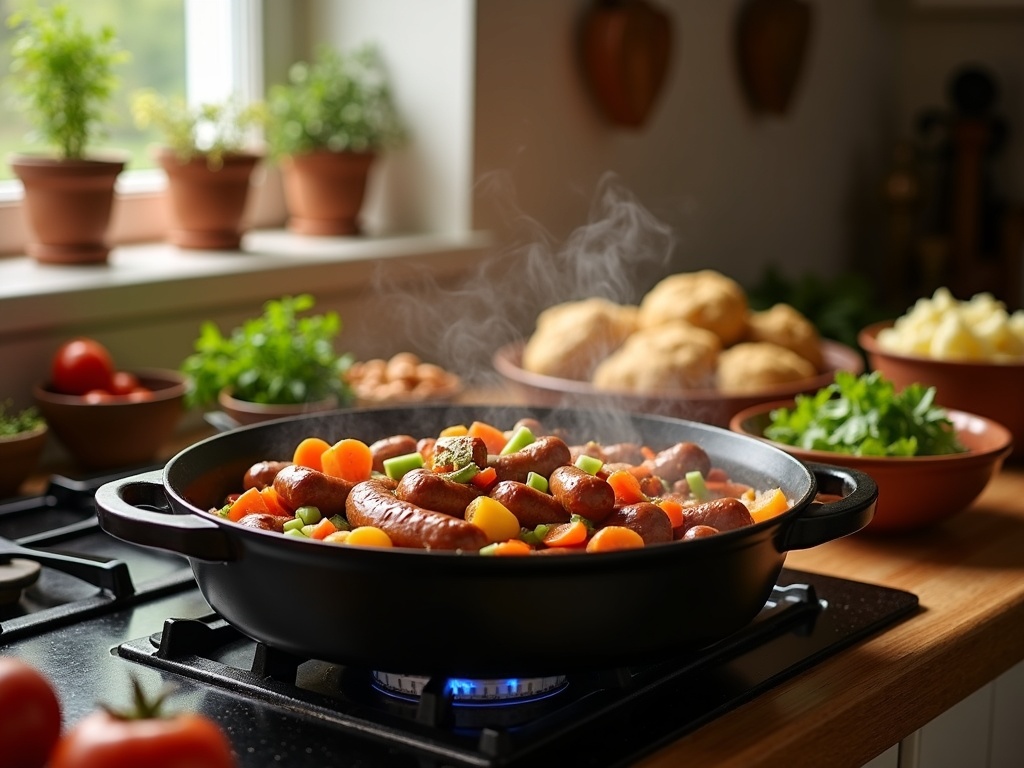
Everything You’ll Need
Creating a delicious sausage casserole starts with gathering quality ingredients. I’ve put together a comprehensive list of everything you’ll need to make this hearty, comforting dish that’s perfect for family dinners or meal prep.
Essential Ingredients
The foundation of any good sausage casserole begins with the sausages themselves. I prefer using Italian or Cumberland sausages for their rich flavor and texture. Italian sausages bring a hint of fennel and herbs, while Cumberland offers a more peppery profile. Both options work beautifully in this dish, so the choice comes down to personal preference.
For the aromatic base, you’ll need onions, carrots, and celery – often called “mirepoix” in culinary terms. This classic combination creates depth in your casserole. I dice these vegetables roughly the same size for even cooking. Garlic cloves are another must-have ingredient, adding that unmistakable aroma and flavor that pairs perfectly with sausages.
The liquid components play a crucial role in developing your casserole’s character. Chicken stock forms the base of the sauce, while canned tomatoes add richness and acidity. If you enjoy cooking with non-alcoholic alternatives, you can skip the red wine, but it does add depth of flavor when the alcohol cooks off.
Herbs and seasonings elevate the dish from good to exceptional. You’ll need:
- Mixed herbs (typically a blend of thyme, oregano, and rosemary)
- Bay leaves (which infuse the sauce with subtle complexity)
- Salt and pepper (for seasoning to taste)
To make the casserole more substantial and nutritious, cannellini beans are an excellent addition. They absorb the flavors of the sauce while adding protein and a creamy texture that complements the sausages beautifully. You can also try protein-rich alternatives if you prefer different beans.
Optional Enhancements
While the ingredients listed above create a fantastic base for your hearty sausage casserole, there are several additions that can take your dish to the next level.
Consider adding mushrooms for an earthy flavor that works wonderfully with the sausages. Bell peppers can introduce a sweet, colorful element, while a splash of Worcestershire sauce provides depth and umami notes. For those who enjoy heat, a pinch of chili flakes or fresh chili can add a welcome kick.
If you’re looking to make the dish creamier, a dollop of mustard stirred in toward the end of cooking adds tanginess and helps thicken the sauce. For a touch of sweetness to balance the savory elements, a small amount of honey or brown sugar works wonders.
When serving, fresh herbs like parsley or basil brighten the finished dish. A side of crusty bread is perfect for soaking up the delicious sauce, or you might pair it with comforting side dishes like mashed potatoes or rice.
The beauty of sausage casserole is its versatility – once you master the basic recipe, you can customize it based on seasonal ingredients or what’s in your pantry. This approach makes it an ideal weeknight meal that can be easily adapted to your family’s preferences.
How To Create This Delicious Meal
Creating a mouthwatering sausage casserole isn’t complicated, but there are key steps to ensure you get that perfect flavor and texture. I’ve broken down the process into manageable steps that’ll help you create a dish your family will request again and again.
Step-by-Step Cooking Method
First, I always start by browning the sausages until they develop a beautiful golden crust. This crucial step locks in flavor and gives the sausages that appealing caramelized exterior. I recommend using a heavy-bottomed pan over medium-high heat with a touch of oil, turning the sausages occasionally to ensure even browning on all sides.
Once my sausages have that perfect color, I set them aside and sauté the vegetables in the same pan. This clever technique allows the veggies to absorb all those tasty bits left behind by the sausages. Onions, carrots, celery, and garlic work wonderfully here – I cook them until they’ve softened but still maintain a slight bite.
The next step transforms these ingredients into a proper casserole. I add liquids and seasonings to create the base of my sauce. Here are some options I’ve found work particularly well:
- Stock (chicken or vegetable) for depth of flavor
- Tomato paste for richness and color
- Herbs like thyme, rosemary, or bay leaves
- Paprika or chili flakes for a gentle warmth
- Worcestershire sauce for umami depth
After adding these elements, I return the sausages to the pan and allow everything to simmer gently. This is where patience pays off – I let it bubble away until the sauce has thickened to a gorgeous consistency and the flavors have melded together. The longer and slower the simmer, the more developed the flavor will be.
About 15 minutes before finishing, I stir in beans – cannellini or butter beans add wonderful texture and protein to complement the hearty meat dish. They also help thicken the sauce naturally while absorbing all those delicious flavors.
The final touch is so simple but makes all the difference: I let the casserole rest for 5-10 minutes before serving. This allows the sauce to settle and the flavors to distribute evenly throughout the dish. This step is often overlooked but makes a noticeable difference in the final taste.
Serve this with crusty bread for a complete comfort meal perfect for chilly evenings or whenever you’re craving something deeply satisfying.
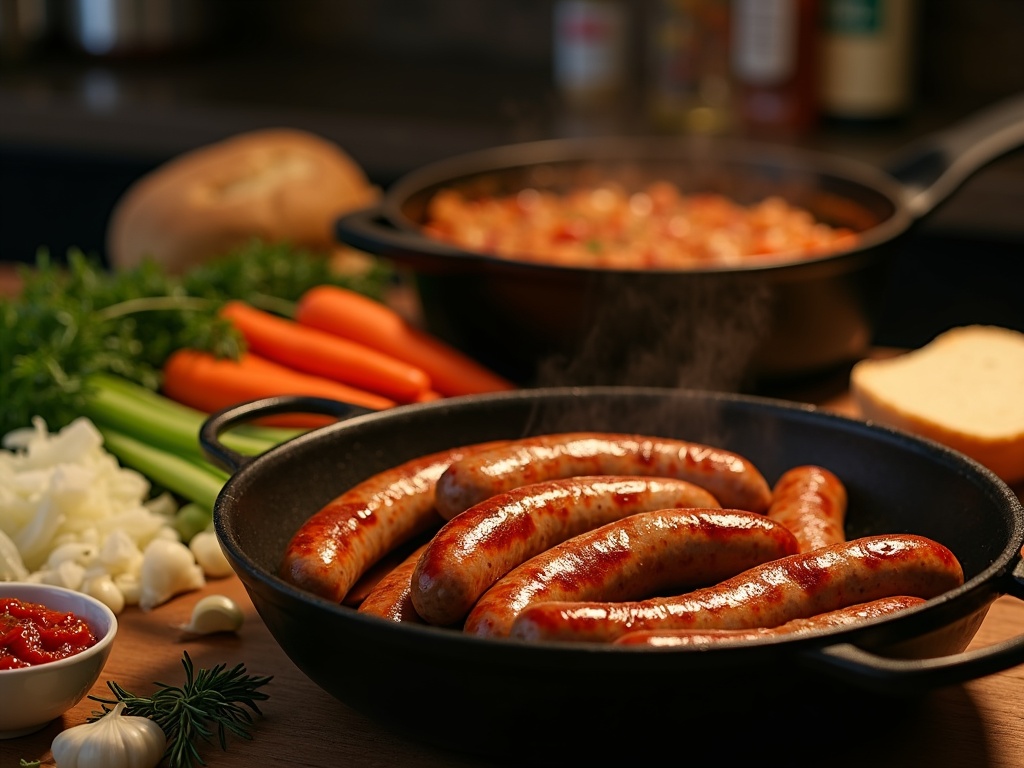
Common Mistakes To Avoid
When making a sausage casserole, the difference between good and extraordinary comes down to technique. I’ve seen many home cooks stumble on the same issues, but with a few adjustments, you can elevate your dish to restaurant quality.
Technique Matters
Rushing the browning process is perhaps the most common error. That golden-brown exterior on sausages isn’t just for appearance—it’s where deep flavor develops. I take my time with this step, cooking sausages over medium heat for 5-7 minutes per side. The caramelization creates compounds that transform the entire dish. If you’re in a hurry, remember that this is the one step worth slowing down for.
Overcrowding the pan is another pitfall that can ruin your casserole. When sausages are packed too tightly, they steam rather than brown. This prevents that beautiful Maillard reaction from happening. I always work in batches, giving each sausage breathing room. This extra few minutes of cooking time pays dividends in flavor.
Adding beans too early in the cooking process can lead to mushy, broken legumes that diminish the texture of your casserole. If using dried beans, they should be properly soaked and partially cooked before adding. For canned beans, I add them in the last 15-20 minutes of cooking. This ensures they maintain their shape while still absorbing the savory flavors of the sauce.
Skipping the resting period might seem like a minor oversight, but it significantly impacts the final dish. Just like with a traditional cottage pie, letting your casserole rest for 15-20 minutes after removing it from the oven allows flavors to meld and intensify. The dish also becomes easier to serve as it thickens slightly during this time.
Flavor Enhancements
Many home cooks miss opportunities to build layers of flavor throughout the cooking process. Here are some key moments to enhance your sausage casserole:
- Use the fat rendered from sausages to sauté your vegetables for an extra dimension of flavor
- Season in stages rather than all at once—different ingredients absorb salt differently
- Consider adding a spoonful of mustard or marmite for depth without obvious flavor
- Incorporate herbs at different times—woody herbs like thyme and rosemary early, delicate herbs like parsley at the end
- Balance the richness with a splash of acid (vinegar or lemon juice) just before serving
Temperature control is crucial throughout the cooking process. After the initial high-heat browning, I reduce to a gentle simmer for the remainder of stovetop cooking. In the oven, a moderate temperature (around 325°F/160°C) allows for even cooking without burning the top. This slow approach gives ingredients time to release their flavors and create that delicious sauce that ties the savory casserole together.
By avoiding these common mistakes, you’ll create a sausage casserole with perfectly cooked meat, tender vegetables, and a rich, deeply flavored sauce that will have everyone asking for seconds.
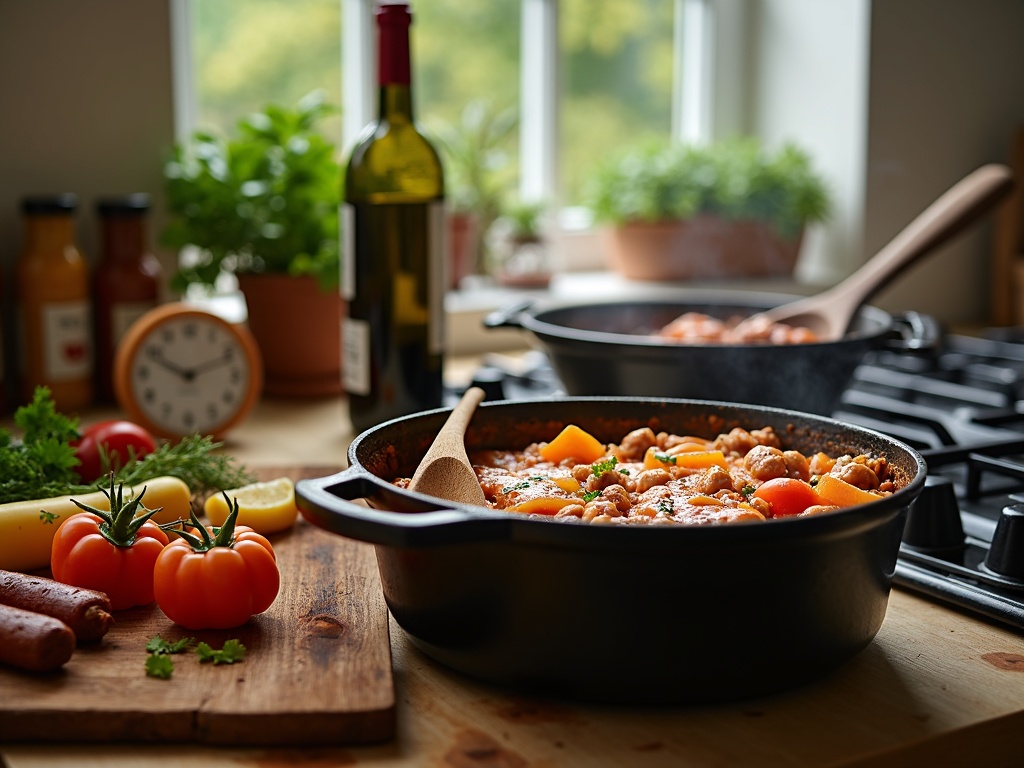
Smart Tips For The Best Results
I’ve found that a truly exceptional sausage casserole comes down to attention to the finer details. These practical tips will transform your casserole from ordinary to extraordinary with just a few thoughtful adjustments.
Perfecting Your Casserole Technique
Selecting high-quality sausages makes a world of difference in your final dish. I recommend opting for sausages with at least 80% meat content and minimal fillers. Beef, lamb, or chicken sausages all work beautifully, depending on your preference. The flavor foundation of your entire casserole depends on this choice, so it’s worth spending a little extra here.
Cutting vegetables uniformly ensures everything cooks at the same rate. I aim for roughly 1-inch chunks for root vegetables like carrots and potatoes, while onions and bell peppers can be slightly smaller. This simple step prevents having some vegetables overcooked while others remain underdone.
The order in which you add vegetables matters significantly:
- Root vegetables (carrots, potatoes) should go in first as they take longest to cook
- Onions and bell peppers can follow after about 15 minutes
- Quick-cooking vegetables like zucchini or mushrooms should be added in the final 10-15 minutes
- Delicate herbs are best stirred in just before serving
Allowing proper simmer time lets flavors meld together beautifully. I’ve learned that rushing this step is a common mistake. A minimum of 40 minutes of gentle simmering creates that perfectly rich sauce and tender meat. For an even more developed flavor profile, consider making your casserole a day ahead and reheating it – the flavors will intensify overnight.
For thicker sauce, I leave the lid slightly ajar during the last 15 minutes of cooking. This encourages reduction without drying out the casserole. Alternatively, a cornstarch slurry (1 tablespoon cornstarch mixed with 2 tablespoons cold water) stirred in during the final minutes works wonders.
If you’re looking to experiment with your casserole, consider adding complementary ingredients like mushrooms, which pair beautifully with sausages in dishes like savory pies as well.
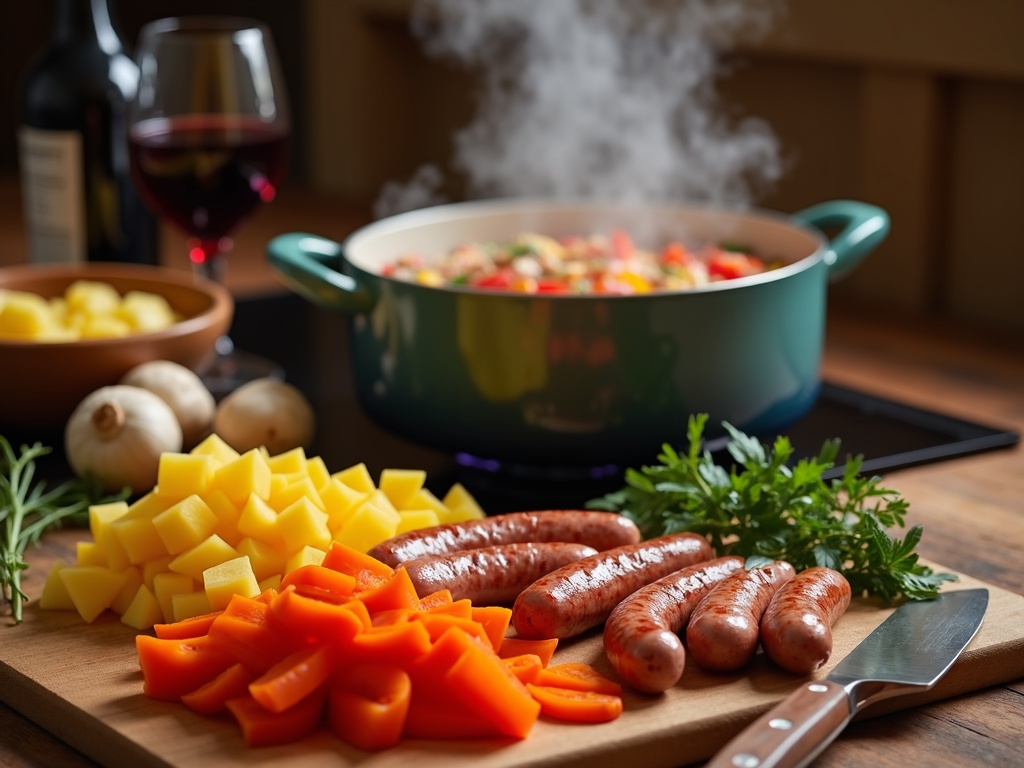
Serving Suggestions
A delicious sausage casserole is versatile when it comes to accompaniments. I’ve experimented with various sides over the years and found several options that perfectly complement the rich, savory flavors of this hearty dish.
Perfect Pairings
Creamy mashed potatoes are my go-to choice for serving with sausage casserole. The smooth, buttery texture creates an ideal base for soaking up the flavorful sauce. For best results, I add a touch of warm milk and butter to my potatoes and whip them until they’re light and fluffy.
Crusty bread makes an excellent alternative when I’m short on time. There’s something satisfying about tearing off a piece of warm bread and using it to mop up the delicious gravy. A rustic loaf or fresh baguette works particularly well.
For a healthier option, I often serve steamed green vegetables alongside my casserole. Broccoli, green beans, or peas add color, texture, and nutritional balance to the meal. They provide a refreshing contrast to the richness of the casserole.
When I want to change things up, rice or pasta can transform the dish completely. A bed of fluffy basmati rice soaks up the sauce beautifully, while pasta, especially wider varieties like pappardelle, creates a heartier meal similar to an authentic ragu recipe.
Don’t underestimate the power of a simple garnish. A sprinkle of fresh herbs like parsley, thyme or chives adds color and a burst of flavor that elevates the entire dish. For special occasions, I might add a dollop of sour cream or yogurt for extra creaminess.
When serving for guests, I like to create a complete spread with homemade sides and complementary dishes. A light salad with a vinaigrette dressing can be the perfect starter before diving into the main event.
The beauty of sausage casserole is its flexibility – it pairs well with almost anything. On cold evenings, I might serve it with additional root vegetables for extra comfort, similar to an Irish stew recipe approach.
Remember that presentation matters too. Serving in individual dishes or a large family-style pot in the center of the table creates a welcoming, communal dining experience that matches the comforting nature of this beloved dish.
Storage And Reheating
The beauty of a good sausage casserole is that it often tastes even better the next day, once the flavors have had time to meld together. I’ve found that proper storage and reheating methods are crucial to maintaining those rich, deep flavors.
Refrigeration and Freezing
Once your sausage casserole has cooled completely, transfer it to an airtight container for refrigeration. The casserole will keep well in the fridge for up to 3 days, making it perfect for meal prep or busy weeknights. Just make sure to cool it within two hours of cooking to prevent bacterial growth.
For longer storage, freezing is an excellent option. I like to portion the casserole into individual or family-sized containers before freezing – this makes thawing and reheating much more convenient. When properly stored in freezer-safe containers or heavy-duty freezer bags, your sausage casserole will maintain its quality for up to 3 months. Don’t forget to label each container with the date to keep track of freshness.
Reheating Tips
The key to reheating any casserole is to do it slowly and gently. For stovetop reheating:
- Transfer the desired portion to a saucepan
- Add a splash of stock or water to prevent drying out
- Heat over medium-low heat, stirring occasionally
- Bring to a gentle simmer rather than a rapid boil
- Allow 10-15 minutes for thorough reheating
That splash of stock when reheating makes all the difference – it revitalizes the sauce and ensures the casserole doesn’t become too thick or stick to the pan. I prefer chicken or vegetable stock, but water works in a pinch.
Before serving your reheated casserole, always check the seasoning. Sometimes the flavors can intensify during storage, while other times they might need a little boost. A pinch of salt, some freshly ground pepper, or even a splash of Worcestershire sauce can bring your casserole back to life if needed.
Variations To Try
The beauty of a sausage casserole lies in its versatility. I’ve experimented with countless variations over the years, each bringing something unique to this humble dish. Whether you’re looking to spice things up or accommodate dietary preferences, these adaptations will transform your basic recipe into something special.
International and Flavor Twists
A spicy Italian sausage version takes this dish to new heights. By swapping traditional sausages for Italian varieties packed with fennel seeds and chili flakes, you’ll create a more robust flavor profile. I add a can of chopped tomatoes and some dried oregano to complement the spicy sausages. The resulting dish has a delicious kick that works wonderfully with a side of creamy pasta dishes or simply some crusty bread.
For a Mediterranean style casserole, I incorporate olives, sun-dried tomatoes, and herbs like rosemary and thyme. The olives add a delightful briny pop that cuts through the richness of the sausage. You could also add some chopped bell peppers and a sprinkle of feta cheese just before serving. This variation pairs beautifully with rich tomato-based sauces and creates a summery feel even in winter months.
Expanding your vegetable selection can transform both the texture and nutritional profile of your casserole. Beyond the standard carrots and onions, I like to add:
- Parsnips for their sweet, earthy flavor
- Turnips for a peppery contrast
- Sweet potatoes for color and natural sweetness
- Celeriac for its subtle celery-like notes
- Fennel bulb for a hint of aniseed
These additional root vegetables not only bulk up the dish but create a more interesting flavor journey in each bite. They’re particularly good when making a larger batch to freeze for later, similar to how you might prepare a hearty cottage pie.
Dietary Adaptations
Vegetarian versions of this classic don’t mean compromising on flavor. Plant-based sausages have come a long way and work wonderfully in a casserole. I find that adding a tablespoon of soy sauce or miso paste helps create that savory depth that meat usually provides. Mushrooms are also fantastic additions to vegetarian versions, bringing a meaty texture and umami richness that complements the plant-based sausages perfectly.
If you’re cooking for someone with gluten sensitivities, ensure your sausages are gluten-free and thicken your sauce with cornstarch instead of flour. The results are just as delicious and no one will notice the difference.
For a burger-inspired casserole, I sometimes add chopped bacon, grated cheese, and serve it with toasted buns on the side – creating a deconstructed version of classic homemade burgers that’s perfect for feeding a crowd.
